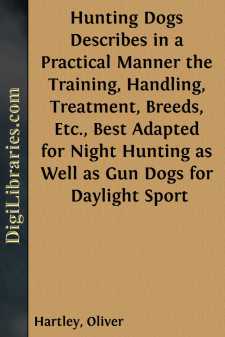Categories
- Antiques & Collectibles 13
- Architecture 36
- Art 48
- Bibles 22
- Biography & Autobiography 813
- Body, Mind & Spirit 142
- Business & Economics 28
- Children's Books 15
- Children's Fiction 12
- Computers 4
- Cooking 94
- Crafts & Hobbies 4
- Drama 346
- Education 46
- Family & Relationships 57
- Fiction 11828
- Games 19
- Gardening 17
- Health & Fitness 34
- History 1377
- House & Home 1
- Humor 147
- Juvenile Fiction 1873
- Juvenile Nonfiction 202
- Language Arts & Disciplines 88
- Law 16
- Literary Collections 686
- Literary Criticism 179
- Mathematics 13
- Medical 41
- Music 40
- Nature 179
- Non-Classifiable 1768
- Performing Arts 7
- Periodicals 1453
- Philosophy 64
- Photography 2
- Poetry 896
- Political Science 203
- Psychology 42
- Reference 154
- Religion 513
- Science 126
- Self-Help 84
- Social Science 81
- Sports & Recreation 34
- Study Aids 3
- Technology & Engineering 59
- Transportation 23
- Travel 463
- True Crime 29
Hunting Dogs Describes in a Practical Manner the Training, Handling, Treatment, Breeds, Etc., Best Adapted for Night Hunting as Well as Gun Dogs for Daylight Sport
by: Oliver Hartley
Description:
Excerpt
CHAPTER I.
NIGHT HUNTING.
Night hunting is a favorite form of hunting sport the continent over. Prime factor of the joyous, though strenuous night quest is the 'coon, the court jester and wit of the nocturnal tribe of small fur bearers.
Owing to the scarcity of other game and general distribution of raccoon the country over, 'coon hunting is gaining in popular favor, winning over many of the wealthy, city-dwelling red-bloods who formerly were content with more or less pleasant and successful sallies to the fields in the day-time.
Consequently there is an increased demand for properly bred and trained dogs to afford the maximum of success and pleasure in this pursuit. With the ownership of dogs go the care, maintenance and proper methods of handling these willing helpers. Surprising is the meagerness of the information available to the average hunter, though night hunting is an institution as old as the settlement of Jamestown.
The craft of developing dogs and using them to the best advantage in this connection, has been by precept and example handed down from generation to generation. Much has been lost in this way and not so much accomplished as might have been attained by aid of the printed and pictured methods of today. Most certainly more attention will hereafter be paid to night hunting, and more painstaking records made and kept for the up-growing practical sportsmen, in which direction the present volume is a long and definite step.
The Court Jester of the Nocturnal Tribe.
Our task is to offer guidance and advice as to the dogs. Yet to do this clearly, the reader must know something of the nature and habits of the animals to be hunted and the effort involved.
A southern gentleman of experience and training has the following to say about 'coon hunting:
The 'coon is a wily little animal, and his habits are very interesting to note. He is a veritable trickster, compared with which the proverbial cunning fox must take a back seat. One of the 'coon's most common tricks employed to fool the hound is known among hunters as "tapping the tree," and which he accomplishes in this way: When he hears the hound's first note baying on trail, he climbs up a large tree, runs to the furthest extremity of one of the largest branches and doubling himself up into a ball, leaps as far as possible out from the tree. This he repeats several times on different trees, then makes a long run, only to go thru the same performances in another place. Onward comes the hound, till he reaches the first tree the 'coon went up, and if it is a young and inexperienced hound, he will give the "tree bark" until the hunters reach the tree, fell it, and find the game not there.
A Pure and A Cross Bred Coon Dog.
All this time Mr. 'Coon is quietly fishing and laughing in his sleeve, perhaps a mile away. But not so with the wise old coon hound. The old, experienced cooner, with seemingly human intelligence, no sooner reaches the tree Mr. 'Coon has "tapped" than he begins circling around the tree, never opening his mouth — circling wider and wider until he strikes the trail again....


